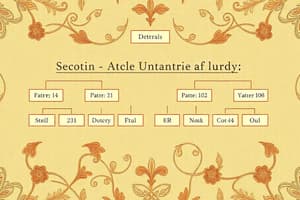Podcast
Questions and Answers
Cal é o primeiro paso na normalización de datos?
Cal é o primeiro paso na normalización de datos?
- Eliminar duplicados da base de datos
- Clasificar os datos por categorías
- Identificar as dependencia de datos (correct)
- Crear unha copia de seguridade da base de datos
A que se refire a 1FN na normalización?
A que se refire a 1FN na normalización?
- Asegurar que non existan grupos repetidos de datos (correct)
- O uso de claves primarias en todas as táboas
- Á eliminación de todos os datos de tipo texto
- A normalización de datos en formato JSON
Que característica é esencial na 2FN?
Que característica é esencial na 2FN?
- Non pode haber relacionamentos entre táboas
- É obrigatorio usar índice en todas as columnas
- Todas as columnas deben depender da clave primaria (correct)
- As táboas deben conter datos de só un tipo
Que implica a normalización de 3FN?
Que implica a normalización de 3FN?
Que se debe evitar durante o proceso de normalización?
Que se debe evitar durante o proceso de normalización?
Cal é o obxectivo principal da normalización?
Cal é o obxectivo principal da normalización?
En que situación sería inapropiada a normalización?
En que situación sería inapropiada a normalización?
Cal é un resultado positivo da normalización?
Cal é un resultado positivo da normalización?
Flashcards
3FN
3FN
Unha das formas normais de Boyce-Codd, é unha forma normal que elimina as dependencias transitivas. Unha dependencia transitiva ocorre cando un atributo depende indirectamente doutro atributo a través dun terceiro atributo.
2FN
2FN
Unha das formas normais de Boyce-Codd, aborda a redundancia. Unha dependencia multivalorada ocorre cando un atributo pode ter varios valores asociados a outro atributo.
1FN
1FN
A primeira forma normal (1FN) é unha base de datos relacional onde cada columna contén un só valor atómico e non se perminten valores repetidos.
Normalización
Normalización
Signup and view all the flashcards
Dependencia transitoria
Dependencia transitoria
Signup and view all the flashcards
Dependencia multivalorada
Dependencia multivalorada
Signup and view all the flashcards
Atributo atómico
Atributo atómico
Signup and view all the flashcards
Formas normais de Boyce-Codd (BCNF)
Formas normais de Boyce-Codd (BCNF)
Signup and view all the flashcards
Study Notes
Video Tutorial 5: Databases
- The tutorial is for CFGS Web Application Development and Multiplatform Application Development students
- The tutorial covers database normalization
- The tutorial includes a complete exercise
Normalization
- The lesson will include a full E-R model
- A Relational Model practice exercise
- Key Concepts of Normalization
- A General Summary of the concepts
Exercise 1
- Students need to create an Entity Relationship diagram and convert it to a relational model.
- The model should meet the first normal form.
- The exercise details involve handling multiple PACs (assignments) for a student and calculating the maximum possible grade.
- Students need to determine the attributes for a student (ID, name, age, and languages).
- Student assignments include the ID, and number of questions, and the date of opening, closing, days accessible, and the maximum points for the assignment. Each question has a value of 0.2 points.
Exercise 1 Diagram
- A diagram illustrating the relationship between 'Alumno' (Student) and 'PAC' (Assignment) data points.
- The diagram shows a many-to-many relationship between the two entities.
- The 'hacer' entity represents the concept of students completing assignments.
- Attributes like 'Id alu' (student ID), 'edad' (age), 'Nombre' (name), 'nota' (grade), 'tiempo' (time).
- Other attributes for PAC data like 'Id pac', 'fecha_aper', 'dias_apertura', 'fecha_cierre', n'numero_preg', 'puntuación_max'
Exercise 1 Summary
- The solution, which includes an E-R and a Normalized model for the database example presented.
- The diagram illustrates attributes and relationships between different tables (e.g. 'ALUMNO','idiomas', 'HACER', 'PACS').
Exercise 2
- Normalizing the "Alquiler" (Rentals) table to 3rd normal form (3NF).
- Students must consider restrictions on the table like multiple rentals of the same book but on different dates.
- The table needs a primary key composed of columns such as 'FechaDeAlquiler', 'CódigoLibroAlquilado', 'CódigoUsuario'.
- Addressing issues like updating user phone numbers, and updating editorial locations.
- Students need to review the restrictions and other important considerations relating to rentals.
Exercise Solution (Normalisation)
- The exercises show how to go from one table to 11.
- Detailed information for "Alquileres" (rental) tables to include attributes such as "FechaDeAlquiler", "CódigoLibroAlquilado","CódigoUsuario","Título Libro", "CódigoEditorial" and "NombreEditorial".
- The process to convert from one table to six related tables in order to normalize the data to 3NF.
Normalization to 1NF
- Eliminating multi-valued fields (e.g., multiple authors, phone numbers) is part of reaching first normal form.
- Creating separate tables for phone numbers and authors are examples here
Normalisation to 2NF
- Ensuring that attributes depend on the entire primary key, not just a portion, is the core of 2NF.
- Removing attributes that are only predicated on partial components of primary keys.
Normalization to 3NF
- Eliminating transitive dependencies.
- Breaking down attributes relying on other non-key attributes.
- Creating a new table, "EDITORIALES", to store editorial information, separate from the "LIBROS" table.
Exercise Summary (Overall)
- The overall solution provided involves normalizing a database to the 3NF.
- Separate tables for rentals, users, books, authors, and editorial information are created.
- Relationships between these tables are shown using foreign keys.
Questions for Review
- The normalization exercise itself.
- Converting E-R diagrams to models.
- The number of strong entities involved.
- The different relationships and their number.
- Why "FechaAlquiler" is a key field in the "Alquileres" table.
- Whether "Autores" is an entity or an attribute.
Contextualization
- Conceptual, Logical, and physical stages of database development.
- Explaining which diagram helps visualize database structure.
- How to use a diagram to display database structure for ease of development.
- Explaining how a model is converted into a usable database.
Studying That Suits You
Use AI to generate personalized quizzes and flashcards to suit your learning preferences.
Related Documents
Description
Este cuestionario está dirixido a alumnos de CFGS en Desenvolvemento de Aplicacións Web e Aplicacións Multiplataforma. A lección céntrase na normalización de bases de datos, incluíndo un modelo E-R completo e exercicios prácticos relacionados. Os estudantes deberán crear un diagrama de relación de entidades e conversalo a un modelo relacional que cumpran coa primeira forma normal.



